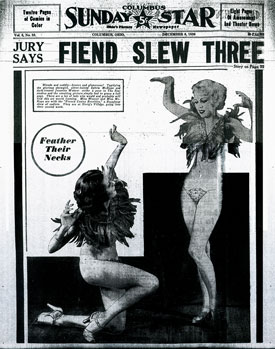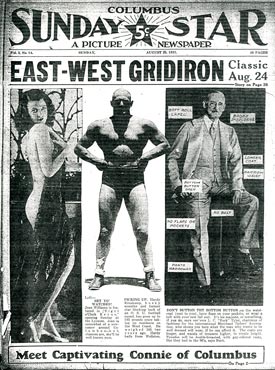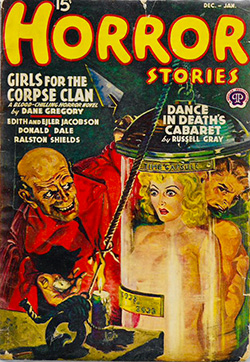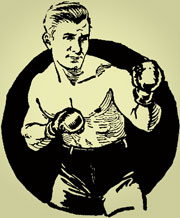THE COLUMBUS SUNDAY STAR (1932-65) Columbus' sensational and daring tabloid newspaper
|
||
Slayers and showgirls in 1936 |
In the early 20th Century, our city had three major newspapers. There was the venerable Ohio State Journal, the morning paper, established way back in 1826. The Columbus Dispatch entered the market as an evening paper in 1871. In 1899, The Columbus Citizen debuted. All three reported the news from a Midwestern, pro-business, pragmatic Republican point-of-view. They spoke for and to white, native-born, middle-class, mostly Methodist men and their families. The papers were socially conservative but not ardently so. The Columbus press disdained Democrats, distrusted populists, hated Socialists, and were wary of trade unions. They were suspicious of foreign nations, cautious of immigrants, and generally isolationist. The city's papers were all energetic municipal boosters, pushing and promoting the city at every chance. The Columbus press was cozy with the powers-that-be, staid, and respectable. In 1932, a new paper appeared on the Columbus scene with a promise to do things differently: The editors of The Star believe there is a place in Columbus for a publication that will delve more deeply into the turbulent life stream that flows past our doors. Beneath the surface of this stream lie a myriad of fascinating stories about human beings, some of them romantic, many humorous and all delightfully interesting. On Sunday, May 22, 1932, The Columbus Sunday Star hit the city's newsstands. It was like nothing Columbus has seen before or since. |
 |
|
The Star lead with a 12-page, wrap-around, color comic supplement. Dick Tracy was there from the beginning and usually first up. Flash Gordon was there after 1934. Milton Canniff's Terry and The Pirates, Superman, Invisible Scarlet O'Neill, Jack Armstrong, and the Phantom all joined by the late 30s. There were some funny strips--Little Annie Rooney, The Gumps, Winnie Winkle, etc.--and a sort of Hollywood Believe It or Not called Seein' Stars in the bunch but mostly The Star's comics were action-packed serials with tough guys fighting foreign spies, crime syndicates, alien warlords, and scheming dames. The appeal of a big, full-color comic section to readers can't be overstated. Comics were a big deal in the mid-20th Century and readers followed them avidly. There was another reason the paper came wrapped in the funny pages. The Star's cover often featured a photo of a woman or women in some state of undress—usually a swimsuit or burlesque costume but sometimes less. Sometimes a lot less. Above-the-waist nudity was surprisingly common. Inside, you got to the news, which consisted mostly of lurid stories of crime, punishment, scandal, and sexual shenanigans from around the city, state and nation. The Star gave over a whole page to the juiciest divorce petitions from the courthouse. If you wanted to read about Congress, the budget, the war, or the President, you looked elsewhere. Ditto for the Governor, Statehouse, and City Hall. The paper steered clear of politics. The Star was never much for muck-raking. It never hounded those in high places. The only rich and powerful it cared to expose were celebrities, royals, or wealthy bad boys and wild girls who'd run afoul of the law. The Star was content to draw its stories from the police blotter, criminal trials, and divorce filings down at the court house. |
Burlesque babes and wrestlers, 1933. |
 |
|
|
The editors at The Star had a knack for headlines that got your attention, headlines that sounded like something from out of a detective or weird menace pulp magazine, the kind of thing you'd find in the latest Spicy Detective or Horror Stories. Some examples:
The headlines almost dared you not to read more. How could you read a headline like Nude Dancing in Graveyard Is Election Issue and not want to know more? |
Rounding out the "hard news" part of the paper were stories like nudist weddings, the worldwide growth of nudism, police raids on local strip joints and illicit bars, the use of nude models in art classes at Ohio State University (art or sex?), and a photo history of the bathtub graced with nude models using it. (Is a pattern emerging?) An especially interesting feature of the old Star was a column written by Col. Frank Lane, a retired Columbus police detective. This column featured retellings of local and regional crimes of note with photos, floorplans, diagrams, and occasionally a sketched recreation of some particularly shocking scene. Crimes ranged from unsolved 19th Century murders in lonely farmhouses to Chicago's latest gangland slayings. Crimes of passion, love triangles, and sexual psychopaths were frequent subjects. Almost inevitably, the victim was female and the body "scantily clad." Bonus points if liquor or narcotics were somehow involved.
|
|
International news was not neglected. Representative of the paper’s coverage of overseas affairs is a 1932 serial by world traveler Rosita Forbes entitled Where There Ain’t No Ten Commandments—a chronicle of sex, skin, sin, depravity, and barbarism in the colonies. The sex lives of strange tribes, the debauched doings of European royalty, and the decadent deeds of French showgirls dominated foreign affairs coverage. The threat of Nazi and Japanese spies and saboteurs received frequent attention in the late 1930s and the 1940s. During the Cold War, the Red Menace got considerable play. In the interest of raising the level of public discourse, The Star also had a science section which focused on critical scientific issues of the day. Examples include: Were the Maya a Lost Tribe of Israel?, Is Life on Earth Doomed?, and Destruction from the Sky (this later one with a neat pen-and-ink illustration of a blazing meteor streaking towards the AIU Citadel Tower). In the later 1940s and 1950s, brainy "atom scientists" and the incredible secret weapons they were alleged to be inventing were much discussed. The emerging space program in the 1950s and 60s lead to alarmist headlines like: Rockets Bare Outer-World Madhouse (The Star never missed an opportunity to work "bare" into a headline.) and Living on Spaceship Like Nice Hangover. |
|
 |
|







